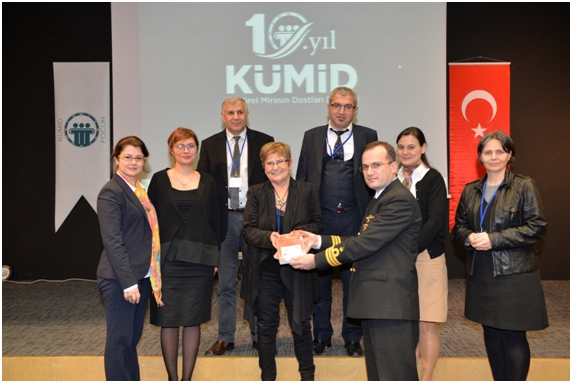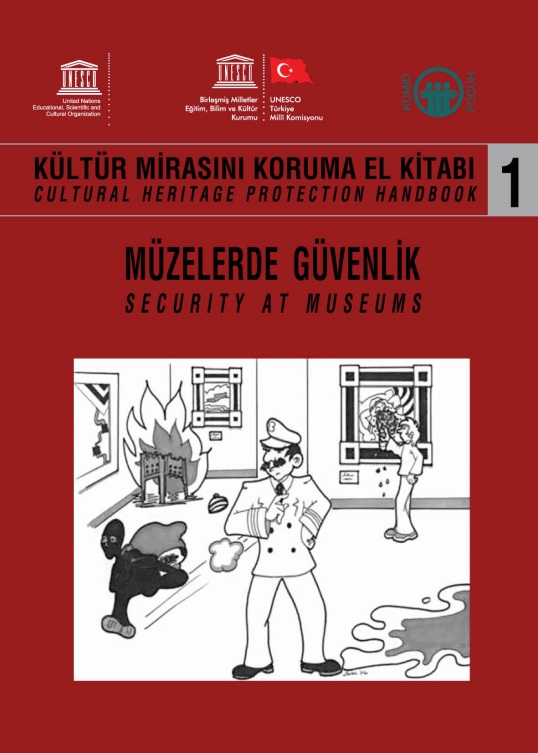by Saadet Güner & Mahmut Aydın (sguner.kumid@gmail.com)
Kültürel Mirasın Dostları Derneği – KUMID (Friends of Cultural Heritage-FOCUH) was established in 2006 as a non-governmental, volunteer-based association in Istanbul, Turkey. Its volunteers and executive board encompass academic scholars, researchers, archaeologists, and private citizens dedicated to supporting the aim of protecting cultural heritage in Turkey and in the World. FOCUH is one of the Institutional Members of Pan-European Federation for Cultural Heritage (EUROPA NOSTRA), The Hague, The Netherlands since May 18, 2006 and one of the members of the Scientific Committee of the International Conference on Cultural Heritage and New Technologies, Vienna, Austria since 2006.

First introduction event for UNESCO-“CULTURAL
HERITAGE PROTECTION HANDBOOK” and ceremony for the 10th Anniversary of FOCUH
took place with the participation of the representative from Turkish National
Commission for UNESCO and related sectors from Istanbul on March 11th 2016 at
Maritime Museum, Beşiktaş, Istanbul / TURKEY (© Friends of Cultural Heritage)
FOCUH’s members have published widely in
journals and book publications, and it has acted as a lead or partner for
various European Union (EU) projects. FOCUH has presented numerous papers at
national and international conferences held in Turkey, Austria, France, Italy,
Jordan, Georgia and Azerbaijan.FOCUH celebrated the 10th anniversary of
its establishment by translating the six volumes of the UNESCO “Cultural
Heritage Protection Handbook” (*) into Turkish, and then publishing and
distributing with its own means in 2016.
The publishing work (1000 Numbers) was crowned with an authorization to
use logos of UNESCO Headquarters and the Turkish National Commission for UNESCO
on the publications.

Figure 1: (*) First of the six books translated into Turkish. UNESCO-
Cultural Heritage Protection Handbooks: 1-Security at Museums, 2-Care and
Handling of Manuscripts, 3-Documentation of Artefacts’ Collection, 4-Disaster
Risk Management for Museums, 5- Handling of Collections in Storage,6-Securing
Heritage of Religious Interest.(© Friends of Cultural Heritage)
The six handbooks were translated into Turkish in cooperation between
FOCUH, Istanbul / TURKEY, Turkish National Commission for UNESCO, Ankara /
TURKEY and UNESCO Headquarter, Paris / FRANCE. Those handbooks expose core
principles for the six topics of security at museums, securing heritage of
religious interest, disaster risk management for museums, documentation of
artefacts’ collections, and care and handling of manuscripts and of collections
in storage. Those principles are aimed to guide museums, religious heritage
managers, museums experts, security officers, collectors and all others
concerned. There is no doubt that
applying those principles is less expensive, yet more effective than
conservation and restoration activities.
An event introducing the UNESCO-“CULTURAL HERITAGE PROTECTION HANDBOOK”
and ceremony for the 10th Anniversary of FOCUH took place with the participation
of the representative from the Turkish National Commission for UNESCO and
related sectors from Istanbul on March 11th 2016 at the Maritime Museum,
Beşiktaş, Istanbul, Turkey. At the end
of the event, FOCUH members and those contributing to the Turkish translation
of the handbooks posed for a family photo and FOCUH’s President, presented a
set of handbooks to the Representative of the Maritime Museum’s Director in
order to give a symbolic start to the distribution of the handbooks in Turkey.
To ensure the sustainability and distribution, and to increase public
awareness of UNESCO-Cultural Heritage Handbook, FOCUH organized a lecture
series in different cities across Turkey (such as Mardin, Batman, İzmir,
Kocaeli and İstanbul) in May 2016, with the kind and voluntarily contributions
of its members. Thanks to the first introductory event, lecture series, and
news published on national media and social media, UNESCO-“CULTURAL HERITAGE
PROTECTION HANDBOOK” Activity of FOCUH reached approximately 20,000 people in
Turkey. FOCUH plans to continue outreach
activities in 2017.
Go back to top